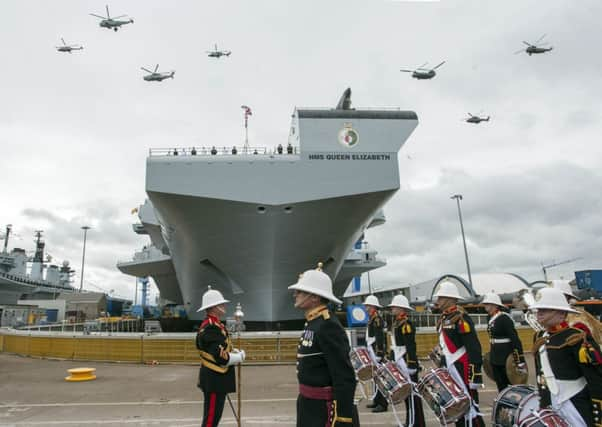Made in Scotland: The HMS Queen Elizabeth


The notes rang across Rosyth Dockyard after the Queen christened the gigantic aircraft carrier, named after herself, with a bottle of whisky smashed against the hull.
This was a ceremony redolent with symbolism. Substituting the traditional bottle of champagne with a bottle of malt emphasised the role played by Scottish shipyard workers and service personnel to construct the 6,500-tonne carrier. A piper played the Mingulay Boat Song.
Advertisement
Hide AdAdvertisement
Hide AdThe overall impression was of an occasion expressly designed to send the message that Britannia still rules the waves, as the military might of the United Kingdom was celebrated in an unashamed fashion.
It was a theme summed up by the First Sea Lord Admiral Sir George Zambellas, who signed off a patriotic speech with the claim that HMS Queen Elizabeth would help keep the “Great in Great Britain and the Royal in the Royal Navy”.
A Red Arrows flypast – that saw the skies painted red, white and blue – was the prelude to an impressive display of pomp and pageantry marking the structural completion of the first of two Queen Elizabeth-class carriers commissioned by the Ministry of Defence. Just 11 weeks away from the independence referendum, it was inevitable that there would be some evidence of Scotland’s political divisions.
A sotto voce but clearly audible booing came from the crowds, clutching Union flags, when First Minister Alex Salmond arrived at the ceremony and his face was beamed on to the big screens. Prime Minister David Cameron triggered a similar reaction when he arrived.
But the most political-sounding speech came from Sir George, who as Britain’s most senior sailor is supposed to be beyond politics. It was difficult not to interpret his speech as a plea for a united Britain.
“HMS Queen Elizabeth is an expression of our national ambition,” the First Sea Lord said. Quoting the Prime Minister, Sir George described Britain as a “small island with a big footprint”.
“We want to be a nation that is influential in the world, to compete strongly in the global race in a world that is increasingly globalised and interconnected and where almost all UK trade is still carried by sea,” he added.
The story of British sea power began in the first great Elizabethan age, said Sir George, before heralding a new chapter of maritime might in a second great Elizabethan age. The first chapter was about “struggle and conquest”, he said. The second Elizabethan age was one of “alliance and partnership”.
Advertisement
Hide AdAdvertisement
Hide AdMany of the Scots present – Mr Salmond included – may have been tempted to point out that the first Elizabethan age pre-dated both the Union of the Crowns and the Union of the Parliament.
But the fact that Scotland was still in its first Elizabethan age did not appear to trouble Sir George, who added: “HMS Queen Elizabeth will be a national instrument of power. That means it will be a national symbol of authority and that means she will be a national icon too, helping to keep the Great in Great Britain and the Royal in Royal Navy.” For onlookers, the most impressive sight was the carrier itself, a warship berthed and assembled in Fife, but with sections built in five other shipyards around the UK – Appledore, Birkenhead, Govan, Portsmouth and Tyne.
The completion of her structure comes five years after work began and 33 months after the first section entered the dry dock at Rosyth for construction to begin.
The ship and her sister vessel, the under-construction HMS Prince of Wales, are the largest warships built for the Royal Navy.
The two ships are being built by the Aircraft Carrier Alliance (ACA), a partnership of BAE Systems, Babcock, Thales and the Ministry of Defence.
Such was the size of HMS Queen Elizabeth, with her four-and-a-half acre flight deck – which will allow F35-B Lightning II fighter jets to take off every 30 seconds – that it was impossible for one aspect of the time-honoured ceremony to be carried out. Omitted from the occasion was the launch itself. The Forth is not deep enough accommodate a vessel of HMS Queen Elizabeth’s size sliding down a slipway and such a manoeuvre would have created a tidal surge.
In the next ten days or so, the dry dock at Rosyth will be filled with water and HMS Elizabeth will be floated out into the estuary in a more sedate manner.
After the ceremony, Mr Salmond was unimpressed by suggestions that yesterday’s event was helpful for the No campaign. With the First Minister was his 92-year-old father Robert, a former petty officer who served on two aircraft carriers during the war.
Advertisement
Hide AdAdvertisement
Hide AdThe First Minister said: “I think it’s been said the Prime Minister was hoping and planning that armed forces day in Stirling, the launch of the carrier, would have that effect. That’s a huge miscalculation.
“People can be proud of the armed forces, proud of the launch of an aircraft carrier, proud to build a ship – that doesn’t dictate their politics.”
The Queen’s attachment to the Royal Navy was reflected in the short speech she gave.
“Lord Mountbatten told my father on becoming king that ‘there’s no more fitting preparation to be king than to be trained in the Royal Navy’,” she said, before urging God to bless the warship and all who sail in her.
Seated with the Royal party were the opposition leader Ed Miliband, the Defence Secretary Philip Hammond and the Chancellor George Osborne. Scottish members of the UK Cabinet were also in attendance with Chief Secretary to the Treasury Danny Alexander and Scottish Secretary Alistair Carmichael joining former prime minister and Kirkcaldy and Cowdenbeath MP Gordon Brown.